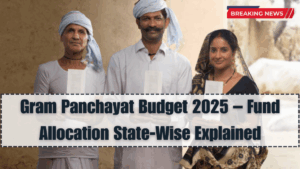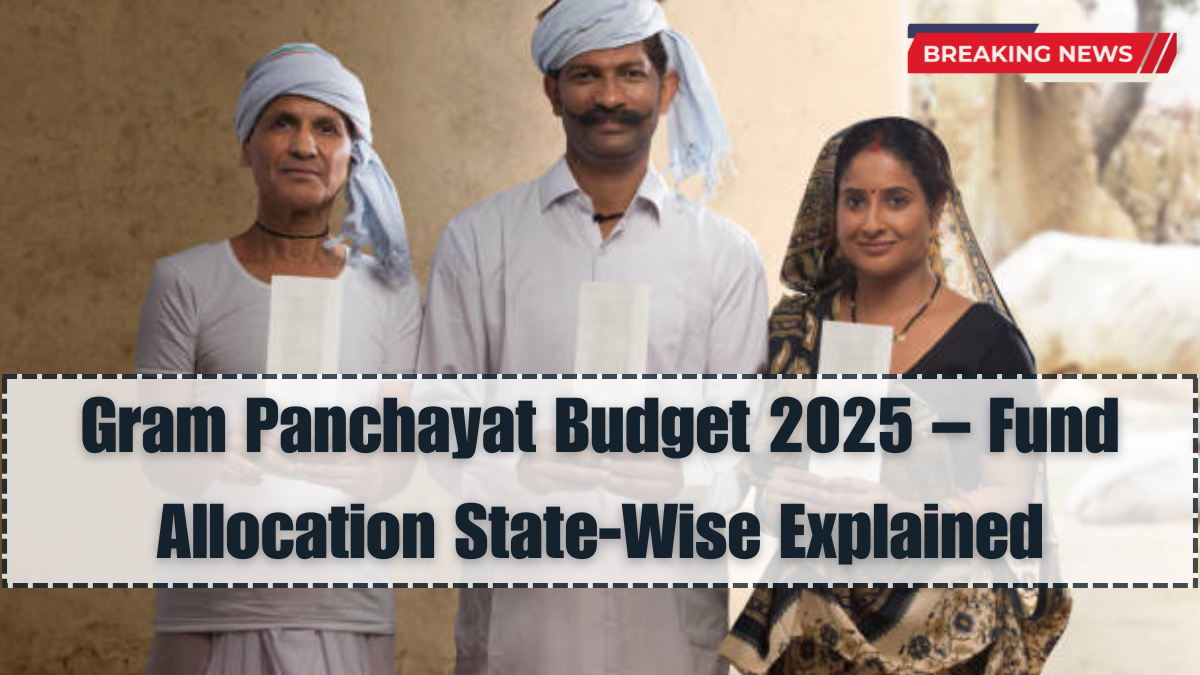The Government of India has officially released the Gram Panchayat Budget 2025, a comprehensive financial blueprint aimed at empowering rural governance and boosting grassroots development. This year’s budget marks a significant increase in funding under the 15th Finance Commission and various centrally sponsored schemes. With increased autonomy, transparency, and digitization in fund allocation and utilization, panchayats are now better equipped to respond to the real needs of their villages.
As per the latest release, more than ₹2.5 lakh crore has been allocated across India’s 2.6 lakh gram panchayats, making the Gram Panchayat Budget 2025 the most robust and inclusive rural development initiative to date. The funds are aimed at improving water supply, sanitation, digital access, education infrastructure, and climate-resilient agriculture.

Key Highlights of the Gram Panchayat Budget 2025
The Gram Panchayat Budget 2025 has been carefully structured to ensure targeted, decentralized development. Here’s what makes this year’s allocations notable:
-
Over 60% of total budget earmarked for basic services like drinking water, waste management, and health
-
30% allocation for human resource strengthening like training, staffing, and capacity building
-
Separate grants for Scheduled Tribe (ST) and Scheduled Caste (SC) concentrated areas
-
Increased focus on climate adaptation, renewable energy, and soil health
-
Mandatory digitized tracking via the eGramSwaraj portal for all expenditures
This approach not only improves governance but brings accountability and visibility to every rupee spent under the Gram Panchayat Budget 2025.
State-Wise Fund Allocation Breakdown
The 2025 rural budget distribution is based on parameters like population, geographic area, and rural needs. Here is a state-wise snapshot of key allocations:
| State/UT | Fund Allocation (Approx.) | Remarks |
|---|---|---|
| Uttar Pradesh | ₹31,000 crore | Highest allocation due to population size |
| Bihar | ₹21,500 crore | Focus on sanitation and education |
| Maharashtra | ₹19,200 crore | Rural health and digitization emphasized |
| Madhya Pradesh | ₹18,400 crore | Emphasis on climate-resilient agriculture |
| Rajasthan | ₹17,000 crore | Drinking water, women’s welfare |
| Tamil Nadu | ₹15,800 crore | Targeting waste management and green energy |
| West Bengal | ₹15,500 crore | Strengthening local schools and hospitals |
| Odisha | ₹13,900 crore | Tribal region-focused development |
This table highlights the government’s strategic approach to funding—balancing need with capacity to utilize and deliver outcomes.
Sectors Covered Under Gram Panchayat Budget 2025
The Gram Panchayat Budget 2025 covers a wide spectrum of sectors aimed at integrated rural upliftment. Each panchayat will receive dedicated grants under the following categories:
1. Basic Infrastructure
-
Construction of rural roads and connectivity upgrades
-
Renovation of anganwadis and primary schools
-
Installation of solar street lighting systems
2. Water & Sanitation
-
Tap water supply under Jal Jeevan Mission
-
Construction of toilets and solid-liquid waste management units
-
Drainage and greywater reuse systems
3. Health & Nutrition
-
Rural health center upgrades
-
Nutrition campaigns in coordination with Anganwadi services
-
Mobile medical units in remote areas
4. Education & Digital Inclusion
-
Smart classroom pilots in government schools
-
Internet hubs and digital seva centers
-
Digital literacy programs for rural youth
5. Livelihood and Climate
-
Farmer skill development under PM-KUSUM and MNREGA
-
Rainwater harvesting and micro-irrigation systems
-
Organic farming and bio-manure units
This multi-sectoral approach ensures that the Gram Panchayat Budget 2025 promotes inclusive development while aligning with national goals.
Digitization, Monitoring, and Public Participation
The implementation of the Gram Panchayat Budget 2025 is being closely monitored through real-time dashboards integrated with the eGramSwaraj and AuditOnline platforms. This ensures:
-
Zero fund diversion
-
Geo-tagging of all rural assets
-
Transparent tendering and expenditure reporting
-
Grievance redressal at local levels
-
Active participation of Gram Sabhas in decision-making
Panchayats are now also required to upload their Annual Development Plans (ADPs) online and align them with SDGs (Sustainable Development Goals), further increasing accountability under the rural development allocation India program.
The Road Ahead: Building Stronger Rural India
With a significant rise in funding, a digitized governance framework, and strong local participation, the Gram Panchayat Budget 2025 serves as a cornerstone for self-reliant rural India. It empowers panchayats to make localized decisions, reduce dependence on central machinery, and improve delivery of core services like water, health, and livelihoods.
Key outcomes expected by the end of 2025 include:
-
100% functional rural water supply in most states
-
Reduction in out-of-school children in panchayat-level schools
-
Increase in female workforce participation via panchayat-led SHGs
-
Transparent utilization of funds, tracked and audited quarterly
The government’s emphasis on capacity-building, digitization, and inclusiveness ensures that this budget directly uplifts millions of lives in the remotest corners of the country.
FAQs
How much total funding has been allocated under the Gram Panchayat Budget 2025?
Over ₹2.5 lakh crore has been allocated for more than 2.6 lakh gram panchayats across India.
What sectors are prioritized under the 2025 rural budget?
Key sectors include water supply, health, sanitation, digital education, agriculture, and livelihood generation.
Is the fund allocation the same for all states?
No, it varies based on population, geographic area, and rural development indices. States like UP and Bihar received higher shares.
How is fund utilization tracked under this scheme?
Through eGramSwaraj, AuditOnline, and geo-tagging of projects, ensuring complete digital tracking and transparency.
Can villagers access the fund usage details?
Yes, Gram Sabha meetings are mandated to share budget plans and fund usage with villagers, encouraging community participation.
Click here to know more.
